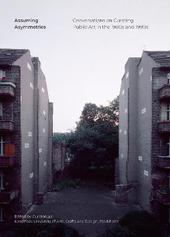
|
Assuming Asymmetries: Conversations on Curating Public Art Projects in the 1980s and 1990s
Paperback / softback
Main Details
| Title |
Assuming Asymmetries: Conversations on Curating Public Art Projects in the 1980s and 1990s
|
| Authors and Contributors |
Edited by CuratorLab
|
| Physical Properties |
| Format:Paperback / softback | | Pages:224 | | Dimensions(mm): Height 229,Width 167 |
|
| Category/Genre | Theory of art
Art and design styles - c 1900 to c 1960 |
|---|
| ISBN/Barcode |
9783956796128
|
| Audience | |
|---|
| Illustrations |
40 B&W ILLUS.
|
|
Publishing Details |
| Publisher |
Sternberg Press
|
| Imprint |
Sternberg Press
|
| Publication Date |
15 November 2022 |
| Publication Country |
United States
|
Description
Conversations from some of the most complex and yet underresearched European and US-American public art exhibitions of the 1980s and 1990s. Through conversations with curators and participating artists, this book revisits some of the most groundbreaking yet under-researched European and US public art exhibitions of the 1980s and 1990s- "Konstrukcja w Procesie," an artist-driven collaboration with the Solidarnos_x0107_ movement in _x0141_ d_x017A_, 1981; "Die Endlichkeit der Freiheit," initiated by artists Rebecca Horn and Jannis Kounellis and playwright Heiner M ller on both sides of the former Berlin Wall in 1990; "Culture in Action," curated by Mary Jane Jacob in Chicago in 1993; "Sonsbeek 93" in Arnhem, curated by Valerie Smith; "Fem tr dg rdar,"curated by Carlos Capelan in Simrishamn and Ystad in 1996; "INSITE," an ongoing series of exhibitions in San Diego and Tijuana launched in 1992; "U-media," curated by VAVD Editions in Ume in 1987; and Ida Biard's "La Galerie des Locataires," which, from 1972 until today, has used the window of a Parisian apartment as an exhibition space. Assuming Asymmetries focuses on questions central to all these projects- How can art productively navigate political tensions? How have artists and curators addressed the ethical asymmetries of the border condition, of inside and outside, working across walls and fences-whether physical, political, or social? Why is participation so hard to catalyze and conduct? How have artworks come to constitute a practice of "situated knowledge," engaging with the contexts in which they are produced or exhibited? And finally, what can we learn from the exhibitions discussed here when developing new, respectful forms of curating today?
Author Biography
CuratorLab is a curatorial course at Konstfack University of Arts, in Stockholm, which is expanding the ideas of curating and the curatorial beyond the exhibition format, exploring radical approaches to engagement, debating pertinent issues of our times, having collective fun, and practicing horizontal learning.
|